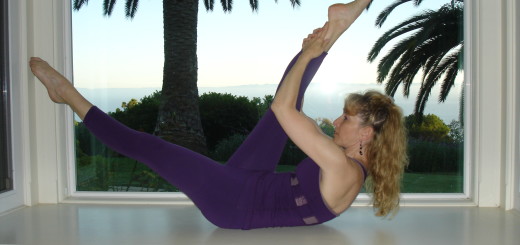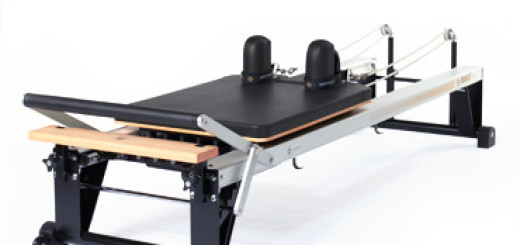Pilates – Wikipedia, the free encyclopedia
Pilates – Wikipedia, the free encyclopedia.
From Wikipedia, the free encyclopedia
Pilates, pronounced /pɪˈlɑ:ti:z/, is a physical fitness system developed in the early 20th century by Joseph Pilates in Germany.[1] As of 2005 there are 11 million people who practice the discipline regularly and 14,000 instructors in the United States.[2]
Pilates called his method Contrology (from control and Greek -λογία, -logia), because he believed his method uses the mind to control the muscles.[3] The program focuses on the core postural muscles which help keep the body balanced and which are essential to providing support for the spine. In particular, Pilates exercises teach awareness of breath and alignment of the spine, and aim to strengthen the deep torso muscles.
[edit] History of Pilates
German born Joseph Pilates designed a system of exercise based on aerobics and yoga postures of Surya Namaskaras.
Pilates was formed by the part Greek, part German Joseph Pilates during the First World War with the proposal to improve the rehabilitation program for the many returning veterans. Joseph Pilates believed mental and physical health are essential to one another. He recommended a few, precise movements emphasizing control and form to aid injured soldiers in regaining their health by strengthening, stretching, and stabilizing key muscles. Pilates created “The Pilates Principles” to condition the entire body: proper alignment, centering, concentration, control, precision, breathing, and flowing movement.
Joseph Pilates wrote two books concerning the Pilates method, Return to Life through Contrology (1928) and Your Health: A Corrective System of Exercising That Revolutionizes the Entire Field of Physical Education (1934).
[edit] Principles
Pilates claimed his method has a philosophical and theoretical foundation. He claims that his system is not merely a collection of exercises, but a method developed and refined over more than eighty-five years of use and observation.
According to practitioners, the central aim of Pilates is to attempt to create a fusion of mind and body, so that without even engaging the mind, the body will move with economy, grace, and balance.[citation needed]
[edit] Breathing
Joseph Pilates believed in circulating the blood so that it could awaken all the cells in the body and carry away the wastes related to fatigue. For the blood to do its work properly, he maintained, it has to be charged with oxygen and purged of waste gases through proper breathing. By this standard, if you stop breathing during exercise, there is an error in your practice. Full and thorough inhalation and exhalation are purportedly a part of every Pilates exercise. Pilates saw forced exhalation as the key to full inhalation. “Squeeze out the lungs as you would wring a wet towel dry,” he is reputed to have said.[citation needed] Pilates breathing should be done with concentration, control, and precision. Proper and effective breathing, practitioners assert, not only oxygenates the muscles, but also reduces tension in the upper neck and shoulders. Pilates breathing is described as a posterior lateral breathing, meaning that the practitioner is instructed to breathe deep into the back and sides of his or her rib cage. When practitioners exhale, they are instructed to note the engagement of their deep abdominal and pelvic floor muscles and maintain this engagement as they inhale. Pilates attempts to properly coordinate this breathing practice with movement, including breathing instructions with every exercise. Joseph Pilates stated, “Even if you follow no other instructions, learn to breathe correctly.”[citation needed]
[edit] Centering
Pilates called the very large group of muscles in the center of the body – encompassing the abdomen, lower back, hips, and buttocks – the “powerhouse.” All energy for Pilates exercises is said to begin from the powerhouse and flow outward to the limbs. In other words, the Pilates technique asserts that physical energy exerted from the center should coordinate movements of the extremities. Pilates felt that it was important to build a strong powerhouse in order to rely on it in daily living. Modern instructors call the powerhouse the “core”.[citation needed]
[edit] Concentration
Pilates demands intense focus. For instance, the inner thighs and pelvic floor may be assessed when doing a standing exercise that tones the triceps. Beginners are instructed to pay careful attention to their bodies, building on very small, delicate fundamental movements and controlled breathing.[citation needed] In 2006, at the Parkinson Center of the Oregon Health and Science University in Portland, Oregon, the concentration factor of the Pilates method was being studied in providing relief from the degenerative symptoms of Parkinson’s disease.[4]
[edit] Control
Joseph Pilates built his method on the idea of muscle control. To him, that meant no sloppy, uncontrolled movements.[5]
[edit] Precision
Practitioners assert that every movement in the Pilates method has a purpose. Every instruction is considered vitally important to the success of the whole. To leave out any detail is believed to forsake the intrinsic value of the exercise. The focus is on doing one precise and perfect movement, rather than many halfhearted ones. The goal is for this precision to eventually become second nature, and carry over into everyday life as grace and economy of movement.
A qualified Pilates instructor is expected to understand the technique well enough to adapt it to the real-world capabilities of his or her students. Students with physical disabilities, for example, should be given a Pilates regimen intended to improve their methods of physically compensating for their ailment.[citation needed]
[edit] Flow or efficiency of movement
Movement is expected to be kept continuous between exercises through the use of appropriate transitions. Once precision has been achieved, the exercises are intended to flow within and into each other in order to build strength and stamina.
[edit] Flexibility
A controlled experiment[6] gives some support to claims that pilates enhances flexibility.
[edit] Use
Traditionally, Pilates is performed using a machine, classically known as the Pilates reformer, which provides exercise resistance to build strength, develop proper alignment and posture, and increase flexibility. Presently, however, mat Pilates, which does not make use of the reformer is becoming increasingly popular. In the absence of the reformer, an individual’s core strength is garnered as resistance to increase flexibility and further develop the core muscles.
[edit] Precautions
Pilates during pregnancy can be a highly valuable and beneficial form of exercise, but the use of Pilates in pregnancy should only be undertaken under guidance of a fully trained expert.[7]
[edit] Legal action
In recent years the term “Pilates” worked itself into the mainstream and, following an unsuccessful intellectual property lawsuit, a US federal court ruled the term “Pilates” generic and free for unrestricted use.[8] While this ruling prevented artificial restrictions on the use of the term “Pilates”, it also permitted many untrained or under-qualified practitioners to capitalize on the name. Consumers may face extensive and conflicting information about what Pilates really is, how it works, and what credentials they should seek in an instructor.[9]
[edit] Certifying organizations
Several of the students of Joseph Pilates who opened their own studios eventually created organizations to teach and certify their own interpretations of the original work.
- Stott Pilates – largest full-service Pilates organization worldwide
- Physical Mind Institute – Eve Gentry – New Mexico
- Kathy Grant – New York University
- Lolita San Miguel – Puerto Rico
- Ron Fletcher – Los Angeles
- Romana Kryzanowska – director of Joseph’s original studio location after Clara retired under the name of Healite. Later sold to Sean Gallagher.
- Bruce King – NY
- Mary Bowen – Northampton, Massachusetts
- Robert Fitzgerald – NY
- Pilates Method Alliance (PMA) – an umbrella organization attempting to standardize certifications.
[edit] References
- ^ Pilates, Joseph (1945 – Re-released 1998). Pilates’ Return to Life through Contrology. Incline Village: Presentation dynamics. ISBN 0961493798.
- ^ Ellin, A. (2005–07-21). “Now Let Us All Contemplate Our Own Financial Navels”. New York Times. http://www.nytimes.com/2005/07/21/business/21sbiz.html. Retrieved on 2007-09-20.
- ^ Pilates, Joseph (1945 – Re-released 1998). Pilates’ Return to Life through Contrology. Incline Village: Presentation dynamics. ISBN 0961493798.
- ^ MSNBC, Pilates may give relief for Parkinson’s patients 2006.
- ^ Pilates, Joseph (1945 – Re-released 1998). Pilates’ Return to Life through Contrology. Incline Village: Presentation dynamics. ISBN 0961493798.
- ^ Segal NA, Hein J, Basford JR. The effects of Pilates training on flexibility and body composition: an observational study. Arch Phys Med Rehabil 2004;85:1977–81.
- ^ Royal College of Midwives (2005). “Pilates and pregnancy” (.pdf). Volume 8, Number 5, pp. 220-223. Royal College of Midwives. http://www.ingentaconnect.com/content/rcm/rcm/2005/00000008/00000005/art00015. Retrieved on September 11 2007.
- ^ US District Court – Southern District of NY, Opinion 96 civ. 43 (MGC) October 2000[1]
- ^ Wall Street Journal, “Is your Pilates Instructor a Health Hazard?”, March 15th, 2005 [2],
[edit] Further reading
- Pilates Trademark Case Judgement US District Court – Southern District of NY : Opinion 96 Civ. 43 (MGC) – October 2000
- Physical Mind Institute (2004). Anatomy of Pilates : The Physical Mind Institute. Sante Fe, N.M.: Physicalmind Institute. ISBN 978-0970530615.
- Blandine Calais-Germain (1993). Anatomy of Movement. Eastland Press. ISBN 978-0939616176.
- Pilates, Joseph (1928). Pilates’ Return to Life Through Contrology. New York, NY: Presentation Dynamics (December 31, 1998). ISBN 978-0961493790.
- Stanmore, Tia (2004). The Pilates Back Book: Heal Neck, Back, and Shoulder Pain With Easy Pilates Stretches. Gloucester, MA: Fair Winds Press. ISBN 978-1931412896.
- Andrew Biel, Robin Dorn (2005). Trail Guide to The Body. Boulder, CO: Books of Discovery. ISBN 978-0965853453.
- Daniel Lyon jr.. The Complete Book of Pilates for Men. Harper Collins (2005). ISBN 0-06-082077-2.


